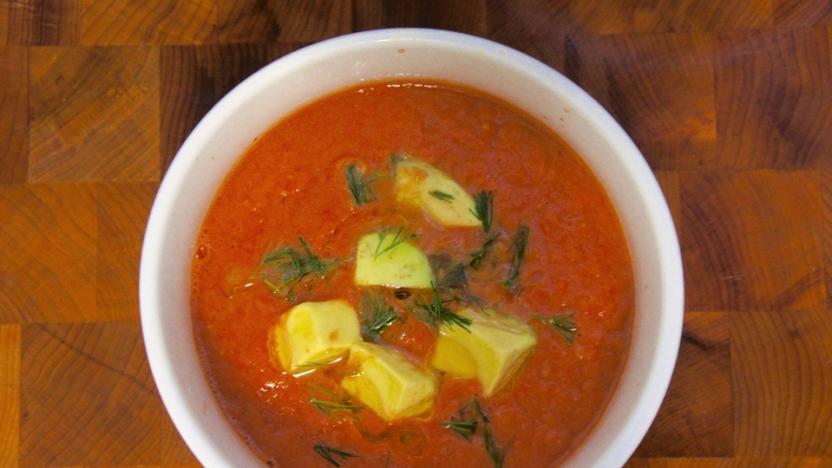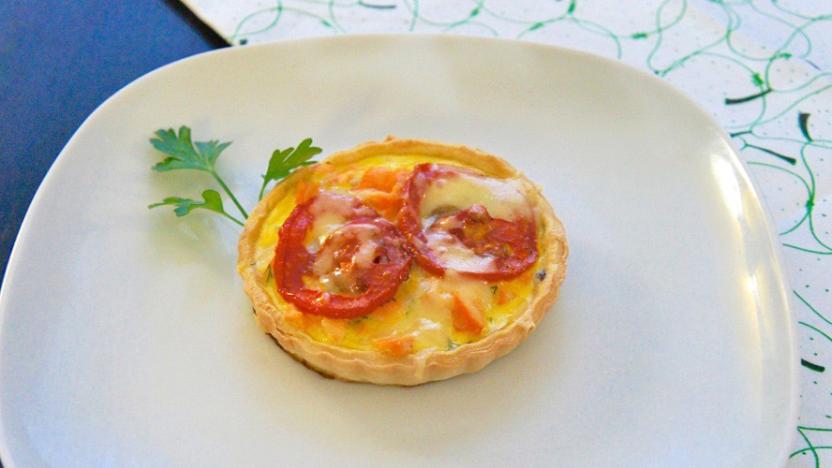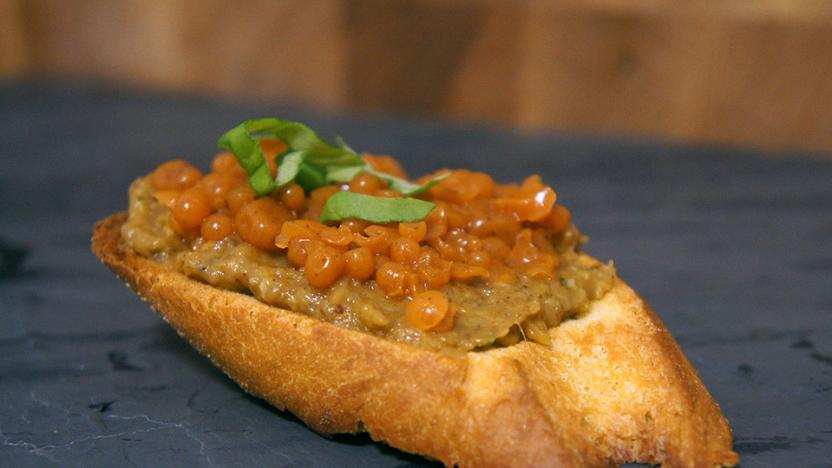cognitivecooking
Latest

Watson's spicy, ginger-laced gazpacho
'Cognitive Cooking with Chef Watson' is a collaboration between IBM and the Institute of Culinary Education in New York City. Once a week, as part of an ongoing series, we'll be preparing one recipe from the book until we've made all of them. Wish us luck. So this is how I knew I was in trouble the first time I saw Cognitive Cooking with Chef Watson (which, by the way, only happened after I agreed to cook my way through the book): there's a specific section for home cooks and it's only seven recipes long. This particular section of the book is a bit different from the rest. For it IBM partnered with Bon Appétit and trimmed the reservoir of recipes that Watson was riffing off of to just the 9,000 or so already in the publication's database. The results are much more friendly for those that don't have access to an commercial kitchen, but they're no less interesting from a flavor profile and serve as evidence that even mortal humans can benefit from Watson's creative kick in the pants.

Now you can try Watson's freaky-deaky recipes for yourself
If you think that a supercomputer can do a better job of inventing new meals than, say, Gordon Ramsey, then today's your lucky day. IBM is opening up its Chef Watson web app to the world, enabling open-minded foodies to make outlandish food combinations for dinner parties with people you're not fussed about pleasing. It's been almost a year since IBM teamed up with Bon Appetit magazine to begin working on the app, and has spent the last eleven months testing it out with a wide variety of willing cooks. In addition to being able to brag about being smart enough to make an Old Fashioned with Chicken Broth, the system is also helping people overcome their dietary problems.

Watson's South American spin on a Canadian classic
'Cognitive Cooking with Chef Watson' is a collaboration between IBM and the Institute of Culinary Education in New York City. Once a week, as part of an ongoing series, we'll be preparing one recipe from the book until we've made all of them. Wish us luck. So far we've just been working from the front of Cognitive Cooking with Chef Watson, towards the back. But we're going to start jumping around a bit now. Partially for convenience sake (it's just easier to make all three poutine recipes in a row), but mostly because I want to avoid using my oven as much as possible. It's hot and humid in New York and I live in a small one bedroom apartment. Basically just looking at my oven makes the temperature rise about 20 degrees in here. So we're jumping a few recipes ahead to take on the Peruvian Potato Poutine, a South American twist on a Canadian classic. This is one of the recipes that Watson inspired the chefs from the Institute for Culinary Education to whip up at SXSW in 2014 at their cognitive computing food truck. So, you can sort of think of this as a Chef Watson 1.0 dish.

Cooking with Watson: Caymanian Plantain Dessert
Cognitive Cooking with Chef Watson is a collaboration between IBM and the Institute of Culinary Education in New York City. Once a week, as part of an ongoing series, we'll be preparing one recipe from the book until we've made all of them. Wish us luck. So for the second week in a row, Watson and his culinary interpreters are appealing to my sweet tooth. Except, where last week's pastries had a savory backbone to keep things interesting, the Caymanian plantain dessert is a full-on tooth-rotting sugar bomb. And a damn delicious one at that. Here's the thing about IBM's cognitive computing project: You never know quite what you're going to get. On the surface the list of flavors here seems like an obvious combination, but as chef Michael Laiskonis points out in the accompanying notes, it's in how they all come together. See Watson isn't just about jamming together seemingly incongruous ingredients. The idea is to push human creativity, in whatever area that may be. It just so happens that in this case IBM is trying to broaden your kitchen vocabulary.

Cooking with Watson: Spanish almond crescent
Cognitive Cooking with Chef Watson is a collaboration between IBM and the Institute of Culinary Education in New York City. Once a week, as part of an ongoing series, we'll be preparing one recipe from the book until we've made all of them. Wish us luck. Watson's latest challenge to my self-esteem and sanity, the Spanish almond crescent, is the first dessert in the Cognitive Cooking book. And it's an incredibly challenging one. But, I'll say this up front, if you put in the effort, the payoff is well worth it. These pastries are quite unique and delicious. They're not so surprising that the first bite catches you off guard, like say last week's Swiss-Thai asparagus quiche. But that's a good thing. These little puffs of sweet and savory are different, but approachable; unfamiliar, but comforting.

Cooking with Watson: Scandinavian salmon quiche
Cognitive Cooking with Chef Watson is a collaboration between IBM and the Institute of Culinary Education in New York City. Once a week, as part of an ongoing series, we'll be preparing one recipe from the book until we've made all of them. Wish us luck. Sometimes, the ingredient lists for these Watson recipes read like a Chopped contestant's worst nightmare. Inside the basket you will find: tart shells, gruyere, sour cream and salmon filets. Almost any time you mix cheese and fish, you know you're in trouble. (Update: I acknowledge that both tuna melts, and bagels with cream cheese and lox are rare exceptions to this rule.) But, if anyone is capable of taming the culinary cruelty of Watson it would be the brilliant minds at the Institute of Culinary Education, like Florian Pinel and Michael Laiskonis. So, even though the idea of a Scandinavian salmon quiche is a little off-putting, I put my faith in the human interpreters to steer me and my captive taste testers in the right direction.

I trusted my gut to IBM's Watson and it gave me a fowl old-fashioned
Cognitive Cooking with Chef Watson is a collaboration between IBM and the Institute of Culinary Education in New York City. Once a week, as part of an ongoing series, we'll be preparing one recipe from the book until we've made all of them. Wish us luck. Before taking the helm at Vogue, where she laid the groundwork for the Devil to wear Prada, Diana Vreeland wrote a series of columns for Harper's Bazaar called "Why Don't You?" In a sort of goop for the 20th century, she would goad the super rich into ridiculous feats of capitalism. "Why don't you rinse your blond child's hair in dead champagne to keep it gold, as they do in France?" she'd ask. Or, "Have your bed made in China -- the most beautiful bed imaginable, the head board and spread of yellow satin embroidered in butterflies, alighting and flying, in every size and in exquisite colors?" Watson seemed to be channeling Ms. Vreeland in Cognitive Cooking, a collaboration between IBM's supercomputer and a group of humans at the Institute of Culinary Education (ICE). "Why don't you make an old-fashioned with a splash of chicken broth and a slice of grilled chicken for garnish?" it inquired. And in the spirit of excess we did just that.

Cooking with Watson: Italian grilled lobster
'Cognitive Cooking with Chef Watson' is a collaboration between IBM and the Institute of Culinary Education in New York City. Once a week, as part of an ongoing series, we'll be preparing one recipe from the book until we've made all of them. Wish us luck. I've got to say I am pretty against the idea of wrapping lobster in bacon. While, yes, bacon does tend to make everything better, I'm also a bit of a purist. I don't like butter or onions in my hamburgers, or mignonette on my oysters. These are foods meant to be enjoyed as they are. And I feel the same about lobster. It is meant to be steamed and devoured as is (or with some drawn butter and lemon if you really must). But, I have a job, and right now that job is to cook whatever Watson tell me to. So it's time to defile one of the most delicious (and expensive) sea creatures with bacon and a lot of citrus.

Cooking with Watson: Indian turmeric paella
'Cognitive Cooking with Chef Watson' is a collaboration between IBM and the Institute of Culinary Education in New York City. Once a week, as part of an ongoing series, we'll be preparing one recipe from the book until we've made all of them. Wish us luck. So, here's a question: Is it still a paella if it doesn't involve olive oil or saffron, and doesn't generally represent the flavors of Spain? At what point does it become a pilaf or, since this particular recipe is brimming with spices from the Indian subcontinent, a biryani? Really the only discernible quality that this Indian turmeric paella has that screams "paella" is the presence of socarrat -- the toasty, browned rice that sits at the bottom of the pan. Oh, and the presentation. And so, here we go again, Watson and his human interpreters from the Institute for Culinary education take a seemingly familiar dish and, with a little computer-generated nudge, create something wholly unfamiliar.

Cooking with Watson: Turkish Bruschetta with carrot pearls
'Cognitive Cooking with Chef Watson' is a collaboration between IBM and the Institute of Culinary Education in New York City. Once a week, as part of an ongoing series, we'll be preparing one recipe from the book until we've made all of them. Wish us luck. Let's get a couple of things straight: Watson, the IBM supercomputer famous for spanking Ken Jennings on Jeopardy, did not really write these recipes in the purest sense of the word. Rather, IBM trained it by feeding it a giant database of recipes, studies on what flavors and smells people find pleasant and information on the chemical compounds found inside ingredients. Using this, Watson is able to suggest dishes with surprising flavor combinations. From there the computer passes the baton to a human being, in this case James Briscione and Michael Laiskonis from the Institute of Culinary Education (ICE), who use the ingredient lists and style suggestions as inspiration for new dishes.


